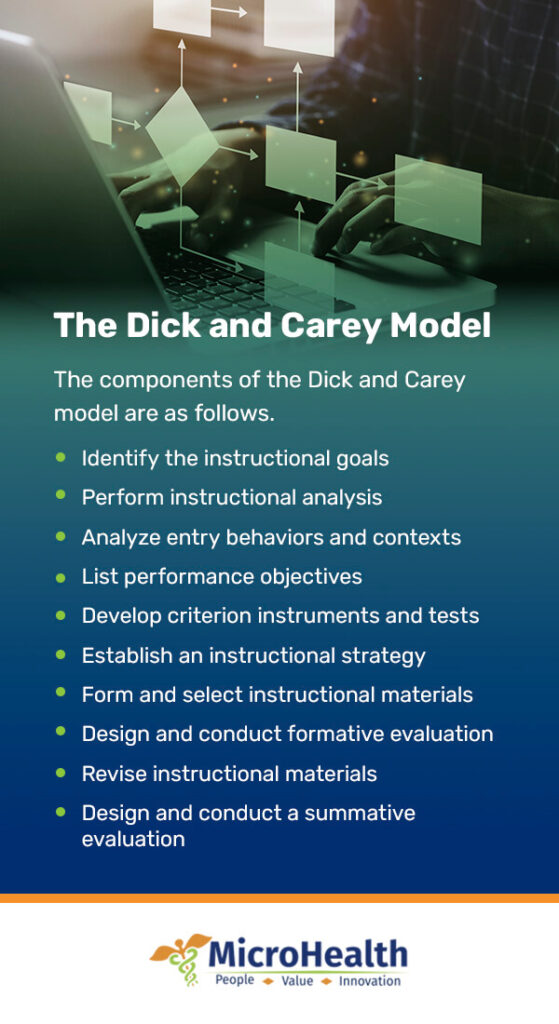
Instructional design is a valuable resource in the healthcare industry because it brings the systematic process of planning and managing instruction to achieve effective learning. It involves translating general learning principles into more specific, detailed instructional materials and methods. An instructional design plan system designs, develops and delivers these materials to successfully achieve desired goals and objectives.
Various resources are available to better understand and use the instructional design process, including instructional technology, educational technology, curriculum design and instructional system design. Within the practice of instructional design, specific models provide value to these plans. Let’s examine the instructional design process, the three models and how it can benefit your healthcare organization.
What Is an Instructional Design Plan?
Instructional systems design is the analysis of learning needs and systematic development of instruction. It also entails using our knowledge of how people learn to guide our choices of sequences and strategies to meet learners’ needs and desired outcomes. Therefore, an instructional design plan allows healthcare specialists to create a document to find the optimal teaching method.
With these plans, healthcare specialists can apply their learning theories, models and principles to create more effective programs. These plans simplify the development of successful and appealing instructional experiences.
The three components of instructional design plans include:
- Learning objectives
- Instructional activities
- Assessment
Instructional design applies to any learner who can use their knowledge to identify the most effective solution. Instructional designers often use technology to facilitate skill and knowledge transfer.
Systematic instruction ensures better quality, so learners can absorb information faster and gain more profound understanding. The instructional designer will analyze the problem, tasks, learning needs and learning environment. Then, they can choose strategies that best fit the goals, drawing on proven strategies and practical experience. From there, the designer will tailor strategies to specific needs and objectives.
What Is the Purpose of Instructional Design?
Instructional design primarily aims to make learning more engaging, efficient and cost-effective through the following steps:
- Define instructional design concepts
- Complete the systems design process
- Practice the design plan
- Review and discuss each model
- Determine what materials and methods will achieve learning outcomes
Instructional Design Models and Methods in Healthcare IT
Instructional design models are the logical guidelines instructional designers follow to create a workshop, a course, a curriculum, an instructional program or a training session. These models represent the instructional design process, showing the fundamental elements or phases and their relationships. Here are the most common instructional design models healthcare specialists may use.
The Addie Model
This model contains several steps under its five phases:
- Analyze
- Design
- Development
- Implementation
- Evaluate
These processes represent an energizing, flexible guideline for building training and performance support tools. The Addie model is the generic process used by instructional designers and training developers. This model is at the very core of instructional design and is the basis of ISD. Effective learning aims for a learner-centered rather than a traditional teacher-centered approach to instruction.
1. Analyze
The analysis phase includes defining the problem, identifying its source and determining possible solutions. It involves gathering information about the audience, the tasks to complete and how the learners will view the content and environment. Instructors identify their learners’ existing knowledge and skills and the project’s overall goals. In conjunction with instructional design theories and models, the outputs from this phase explain how to acquire information.
2. Design
During the design phase, instructional designers create their projects using the outputs from the analysis phase to plan a strategy for developing the instruction.
Elements of this stage may include:
- Learning objectives
- Writing a target population description
- Assessment instruments
- Exercises
- Content
- Selecting a delivery system
- Subject matter analysis
- Lesson planning and media selection
The design phase should be systematic and specific.
3. Development
The third phase, development, involves creating activities to implement. This phase requires assembling the following elements:
- Writing and publishing materials
- Creating storyboards and designing graphics
- Developing all media used in the instruction, such as hardware and software
4. Implementation
Implementing the content is installing the project in a real-world context. Instructional designers use this stage to determine if all materials are functional and appropriate for the intended audience. It also requires training facilitators and learners. This phase covers delivery methods and learning outcomes for maximum effectiveness.
5. Evaluation
The final phase ensures the materials achieved the desired goals and measures instructional efficiency. In this process, the designers can assess and revise the project’s elements if necessary, making the Addie model an iterative process. This ongoing phase should occur throughout the entire process. The evaluation phase consists of the following two parts.
- Formative evaluation: This multidimensional component is present in each stage of the Addie process. Formative evaluation improves the instruction before implementing the final version.
- Summative evaluation: Summative evaluation includes testing and evaluating content, and usually occurs after instruction. This final phase is vital for the instructional design team because it provides data used to alter and enhance the design. Throughout summative evaluation, the instructor should ascertain if the training program solved the relevant problem and met the desired objectives. Data from this evaluation leads to more informed decision-making.
The Dick and Carey Model
The Dick and Carey model, also known as the systems approach model, is a well-known structure first published in 1978 by Walter Dick and Lou Carey. This instructional design model specifically targets skills and knowledge and supplies conditions for learning outcomes. This entire system focuses on content, the interrelationship between context, learning and instruction. The components of the Dick and Carey model are as follows.
- Identify the instructional goals: Determine the real-world abilities, information, behaviors or attitudes learners must acquire.
- Perform instructional analysis: Describe what learners must recall to perform a specific task.
- Analyze entry behaviors and contexts: Understand your learners’ behaviors, traits, experience, current knowledge, motivation and other factors that may influence the learning experience. Analyze the learning settings and what learners will need to meet the objectives.
- List performance objectives: Designers should write measurable goals consisting of behavior, condition and criteria used to assess a learner’s performance.
- Develop criterion instruments and tests: Create criterion-specific tests to monitor instructional effectiveness and progress, such as pre-tests, post-tests and practice items.
- Establish an instructional strategy: Your instructional strategy should use appropriate learning theories and reflect your analysis. Include pre-instructional activities, learner participation, content presentation and assessment.
- Form and select instructional materials: Once you have defined your learning strategy, decide which exercises, tools and delivery media you will use. These materials may include group-based, facilitated, face-to-face or online learning tools.
- Design and conduct formative evaluation: Assess how effectively you have created the learning initiatives. Identify opportunities for improvement through review and feedback.
- Revise instructional materials: Determine whether there are poor test items or unsuccessful instruction methods. Use this phase to revise the instruction and make it as effective as possible for most students. Continually revisit and improve throughout the instructional design and development process to deliver the best possible outcomes.
- Design and conduct a summative evaluation: As in the Addie model, perform a summative evaluation to assess how effective your delivered initiative has been based on results. Determine whether participants are satisfied with the course and whether their knowledge and skills have improved.
The Kemp Model
The Jerrold Kemp instructional design method and model — developed in 1971 — defines nine components of a continuous implementation/evaluation model. The Kemp model considers each designer’s uniqueness and draws from several disciplines and approaches to instructional design.
Kemp’s model adopts a broad view due to its structure. Unlike linear methods like the Dick and Carey model, the Kemp design model is circular. It allows you to begin the design process in any stage and to perform multiple stages simultaneously. Depending on the process and design, some steps may not even be necessary.
Continuous planning, design, development and assessment are necessary to ensure effective instruction. Here are the nine steps of the Kemp design model:
- Define the learning outcomes and instructional problems for the course.
- Identify learner characteristics to consider during the planning process.
- Determine and clarify course and subject content and analyze the proposed task components in relation to the course’s goals and purposes.
- Define instructional outcomes for learners.
- Ensure the instructional unit content is sequential and logical.
- Design instructional strategies that enable learners to master content.
- Plan the instructional message and mode of delivery.
- Develop evaluation instruments for measuring and assessing learner progress toward achieving goals.
- Select the appropriate resources to support teaching and learning activities.
Why Is Instructional Design Important?
Often, educators must develop courses and methods that help learners understand how to perform medical procedures. If not well-designed, this instruction risks being incomplete, informal, unstructured and variable among learners, leading to undesirable outcomes. An instructional design model helps optimize teaching to craft courses and curricula in medicine and ensures clear learning objectives. Here are the benefits of instructional design plans.
- Alignment: Instructional design creates a cohesive, organized system that aligns content, assessments and objectives. Learners will understand their instructors’ expectations.
- Instruction quality: Medical educators use evidence-based instructional design to maximize high-quality instruction. By targeting specific learner needs and using trial by error, educators can improve learning materials and overall experience.
- Replicability of processes: When faculty design and develop courses and materials, it can be challenging for others to step in and teach. Instructional design makes these steps explicit and replicable, so other skilled instructors can take over courses and curricula. Modules can use the same overall strategy and design with simple modifications to content, assessments and objectives.
Access Healthcare IT Solutions With MicroHealth
Instructional design plans can help you train your staff with better resources and materials for learning to improve your operations, increase productivity and ensure your staff meets strict industry demands. Using the different models, you can achieve effective learning within your facility that extends to patients, payers and overall public health.
At MicroHealth, healthcare IT is our specialty. We’re also technologists, and we have the sustainable business solutions you need to maximize learning and enhance instructional delivery. Whether you need better healthcare IT service management or clinical information systems, we have everything you need to support your clinical workflow design and modernize your mission. Reach out to us today to learn how our software and services can improve your instructional design.




